While they may look similar on the surface, Google and Baidu are very different search engines, and require a completely different approach when optimizing for organic traffic. Nowhere is this difference more evident than on their Search Engine Results Pages (SERPs) and their usage of rich snippets. While Google is much more limited in both the quantity and diversity of rich snippets on their SERPs, it’s not unusual to see the entire first page of Baidu occupied exclusively of rich snippets.
In this harsh environment, does a smaller site or international organization stand a chance in pulling in organic traffic from Baidu? It’s possible, but not without a significant re-think of your SEO strategy.
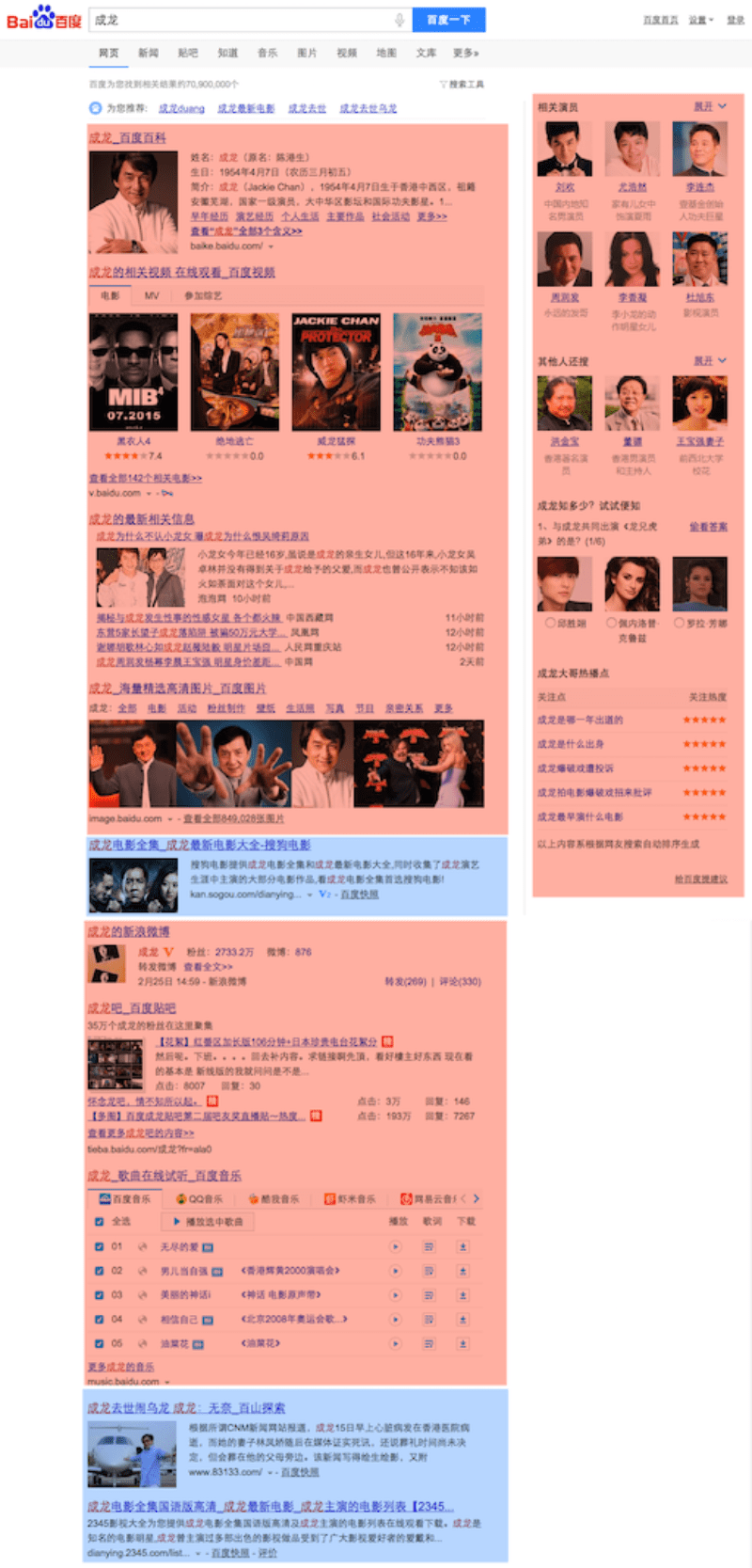
A not-uncommon Baidu SERP. Areas in blue represent non-Baidu organic results.
Over the past year, we’ve spent a large amount of time researching and analyzing thousands of Baidu SERPs. In this article, we’d like to share some of our findings and analysis with you. You’ll find out how rich snippets affect the SEO landscape on Baidu, along with tips on how to restructure your SEO strategy to maximize your organic search visibility in China.
As you read this article, you’ll definitely want to keep our glossary of Baidu SERP result types handy. This glossary contains over 100 different rich snippet result types on Baidu, and is referenced heavily in this article.
With over 100 distinct rich snippet result types being shown on average of more than 4 per page, Baidu SERPs can be a jungle. Baidu claims this liberal usage of rich snippets and universal search results is for the lofty and benevolent goal of improving the user experience. However, many searchers and SEOs disagree with this premise. As we dig deeper into the all the different types of rich snippets, you may begin to understand why.
Before we talk about strategies on how to rank well in this environment, let’s start off by examining 4 general categories of rich snippets on Baidu.
User experience-based rich snippets answer a searcher’s question as quick as possible for queries with less commercial intent. In Baidu, this kind of result are usually triggered by informational queries which the source of information are governed or very standard, such as weather, dictionaries, poems and quotes, calculators etc. These types of rich snippets can be seen quite often in Google via knowledge cards as well.

Hong Kong weather report rich snippet
Baidu provides a huge variety of formats in their search ads, especially when compared to other search engines like Google. While Google Adwords is quite standardized with one headline link and a short amount of text, Baidu ads may be very large, contain images or other rich media, multiple links, and custom formats.
Due to their pervasiveness and how poorly-labeled they are, Baidu ads will affect your organic visibility tremendously, especially for competitive search terms. We would like to note that signing up for a Baidu SEM account is far more restrictive than for Google or Bing, with a lot of red tape to cut through before your first ad can be shown. Foreign companies who are interested in promote their business on Baidu will likely have to work with a local agency.

A Product Listing Ad promoting JingDong’s antiques in Baidu
Baidu owns a vast empire of sites and content on the Chinese web, such as the Wikipedia-style Baike, Q&A site Zhidao, or forum site Tieba. In addition to these on Baidu’s own domain, they own full or partial stakes in many other sites on the web, such as travel sites Qunar and_ Ctrip._
Baidu creates their own custom-designed rich snippets to provide extra exposure to their own products. It’s not the first time we see search engines give their own products with privileges in their ranking algorithms, but Baidu really takes it to the extreme. In our research, we’ve found that Baidu’s own properties occupy an average of 40% of results on page 1!
For SEOs in China, this has become a very large and unique challenge over the years. Baidu services and products are so diverse and rapid changing, and it can be very difficult to know how to beat Baidu at their own game. See below for more tips on how.

A Baidu Nuomi (China’s Groupon) rich snippet showing group deals from restaurants near the searcher’s location
Another interesting difference between Google and Baidu is how they monetize their search engines. While many complain Google isn’t transparent enough, Google strongly defends its impartiality in its search results. No matter what certain conspiracy theorists say, you cannot buy your way to better organic results on Google.
Baidu emphasizes their focus on providing best user experiences for their users, but it’s not difficult to see the stronger commercial intention on how Baidu sees their search business.

Baidu will often display custom-designed rich snippets in multiple formats for their business partners on their SERPS. However, these snippets won’t contain any trace of clues that this is an advertisement, such as the Sponsored tag within the snippet.
A rather obvious way to look for this kind of partnership are from industry’s news stories as they are often covered. This is kind of partnership is called Aladdin (阿拉丁). Here are a few notable press releases about Aladdin projects between Baidu and HC360, Microsoft, Autohome, ZOL and Qunar (all links in Chinese).
Now take a look at how some of these sites are shown with rich snippets in Baidu:
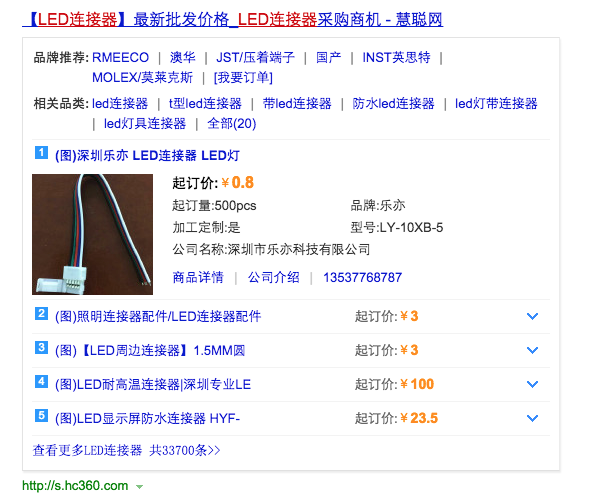
One of the custom shopping snippets Baidu designed for HC360. These may appear any time a user search for a product HC360 carries
These partnerships go way beyond typical SEO strategies, and have historically only been launched for some of the most influential enterprises in China. So unfortunately for most of the SEOs, getting these kinds of rich snippets in Baidu for your websites just isn’t a possibility. It is just not a level playing field. These types of rich snippets, to the best of our knowledge are limited to back-room deals with Baidu, only available to a select few.
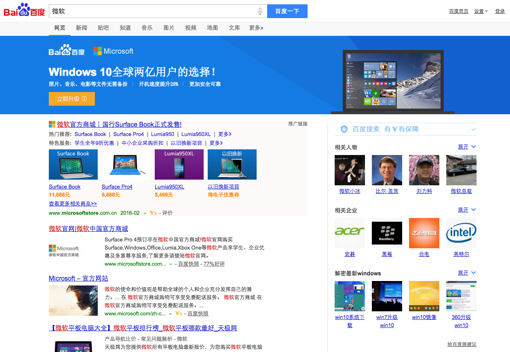
A top banner snippet that promote Windows 10 upgrade will appear when searching for 微软 (Microsoft in Chinese)
If you are interested in knowing most of the different rich snippets formats in Baidu, check out our glossary of Baidu rich snippets.
Now that we know a bit more about how your organic ranking can be pushed down by rich snippets in Baidu, let’s take a look at how to adopt a better SEO strategy to succeed in this environment.
The first question you should be asking is, how are rich snippets are affecting the particular keyword groups we are targeting? Different types of keywords will have a drastically different number of rich snippets — some keywords may display 100% rich snippets on page 1, while others can be 0%.
If you’re optimizing for a group of head terms with a relatively small number rich snippets on the SERP, your strategy will be completely different than if the SERPs for all targeted head terms are covered in rich snippets.
Manually searching Baidu for the phrases you are targeting is great for understanding exactly which SERP features appear on the page, but can be an extremely time-consuming process. Dragon Metrics provides tools to help with this process while you’re still in the keyword research phase, and can save a huge amount of time.
In Dragon Metrics has developed a metric called SERP score to assess the organic SEO environment of each keyword on the Baidu SERP. With this single number, you can see how Baidu-owned properties, ads, and rich snippets are affecting a particular SERP in Baidu. In essence, SERP Score is a measure from 0 to 10 on how suitable this keyword is for typical organic SEO tactics. The fewer Baidu-owned properties, ads, and rich snippets appearing on page 1 for a keyword, the higher the SERP Score will be.
You can perform SERP score lookup in Dragon Metrics in the Baidu Research area or with the Baidu SERP Analysis Tool. (A Dragon Metrics login is required to access these features. If you don’t have an account, you can sign up for a 30-day free trial, no credit card required.)
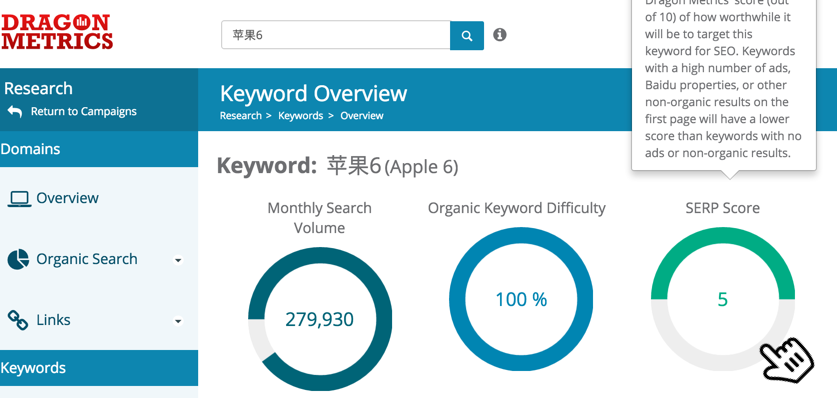
SERP Score in Dragon Metrics “Baidu Research” Feature
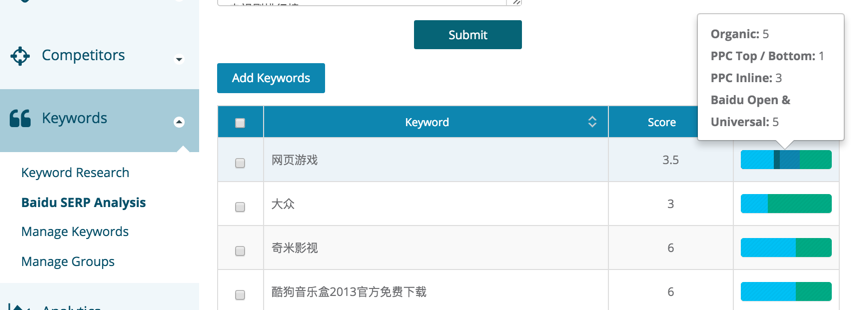
Dragon Metrics Baidu SERP Analysis Feature
To illustrate how SERP score can show rich snippets appearances on a SERP, here are two SERPs, one with SERP score of 4 and the other one with 10.
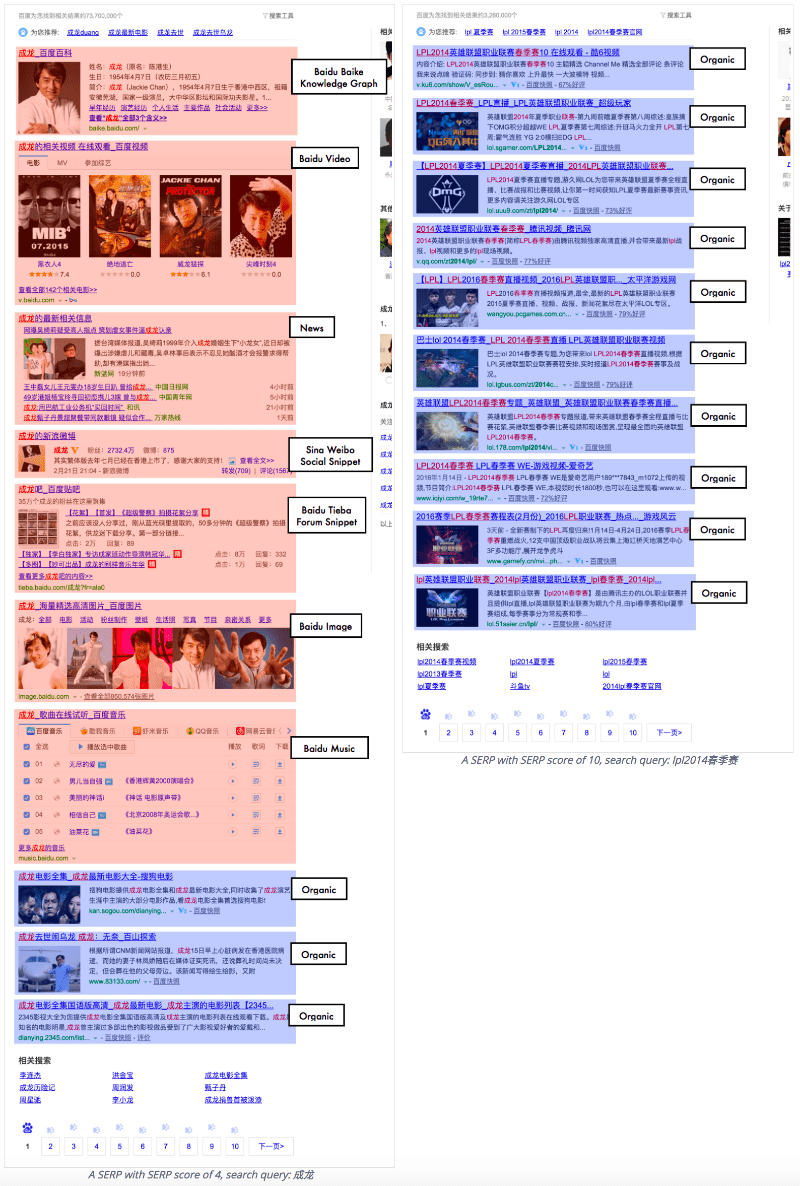

When Jackie Chan tries to find his official fan site in Baidu
See the difference? It’s nearly impossible for any website to outrank these Baidu properties, so even if you secure the #1 non-Baidu organic position, you’ll receive little traffic since your site is displayed so far down on the page.
If post-analysis, you find your targeted keywords have very few rich snippets, you are indeed one of the lucky ones. Continue with a normal SEO strategy if you’d like, or use the tips below to gain a bigger piece of the pie.
For most other industries, you’ll find you’ll need to develop a custom strategy on how to get organic traffic on Baidu when there are so many rich snippets on page 1. Read on for tips on how to take this on.
The most ideal strategy is to get your own rich snippets ranking on Baidu. While this approach is certainly challenging, it’s not impossible, so it’s a good first step to look into this for your site.
Baidu uses both Baidu Webmaster Tools and Open Platform for the submission of structured data. Schema markup is not supported, and there are certain constraints for SEOs to apply. For example: Business info related rich snippets often require a company registration in China, and ICP certification. Some other rich snippets are only available for a small group of websites (usually Baidu’s chosen closed beta participants or a list of authoritative websites in China).
The structured data submission tool in Baidu Webmaster Tools offers many types of basic structured data in Baidu. However, the types of data sites can submit to them will be limited according to websites’ authority in Baidu and participation in Baidu’s beta projects or forum discussions.
Submitting structured data through Baidu Webmaster Tools won’t guarantee they will use them on their SERPs, but will at least get you in the running. Also, most of them are simply enhancements to your organic search snippets, which means if you are not ranking well in these SERPs, getting these rich snippets probably wouldn’t help much on your traffic. Even still, they are one of Baidu’s standard and easiest way for rich snippet acquisition, and all Baidu SEOs should be familiar with what kind of rich snippets are within their reach.
We’ve written a guide on how to submit structured data for your site using Baidu Webmaster Tools that you’ll definitely want to check out.
Baidu Open Platform is a way that sites can create widgets to be placed on the Baidu SERP. There are many rich snippet options if your sites is qualified and has submitted structured data correctly. To start doing so, you will need to log in to Baidu Open Data Platform with a Baidu account. Since most of the rich snippets in Baidu Open Platform will require China company registration and ICP certification in most cases, we won’t be covering the usage of Baidu Open Platform in this article.

A rich snippet of Apple’s official China customer hotline, with a Baidu verified image on the left. Applied through Baidu Open Platform.

Getting Baidu rich snippets for involve effort outside normal SEO. If you’re not a large organization, or have a physical presence in China, chances are these opportunities won’t be available for you.
But getting your own rich snippets in Baidu isn’t the only way to get organic traffic. There are several other strategies you can enlist to boost your organic visibility.
Some of the biggest successes we’ve seen from smart sites are from going after the long tail. While there’s no doubt it’s tough to rank for top terms in Baidu, embrace the fact that you’re targeting the most populous country on earth. 1.4 billion people in China means there is a very long tail of keywords out there. The massive search volumes from head terms may seem attractive, but don’t forget the value of the millions of long-tail keywords that could be sending traffic to your site.
Examine your industry and verticals, and do some keyword research in Dragon Metrics. Keep in mind that Baidu, like Google, may not show results for non-commercial intent keywords, so always take this with a grain of salt when considering long-tail keywords. Then create content targeting these keywords. We’ve seen many sites use this approach to grab many quick wins without universal search visibility.
Ranking above Baidu’s own properties is often impossible or extremely difficult. They’re just not playing fair. That doesn’t mean you can’t get a share of this traffic — it just may be from an indirect source.
Instead of trying to rank above Baidu’s properties with your own website, create content in these platforms that is friendly to your site (and potentially linking back to your site within the content). Then work on getting these pages ranking high on Baidu. You’ll have a much less uphill battle this way.
Baidu properties containing user-generated content like Baike (Baidu’s Wikipedia), Zhidao (Baidu’s Quora) and Wenku (Baidu’s Slideshare) are perfect for this. Since they rank very highly for a large percentage of keywords, they get plenty of visibility already. With multiple links displayed for each property’s rich snippet, there are many opportunities to get your content onto page 1 of Baidu.
This strategy is often regarded as Barnacle SEO, since you’re attaching yourself to a high-ranking site, much like a barnacle attaches itself to a seafaring ship for a free ride. Successful marketers in China have mastered barnacle SEO, and many find it justifiable investing more effort in barnacle SEO than building up their own web properties. This is extremely true for smaller sites.
A copy-and-paste strategy for taking your site to China will not work. Many organizations are astounded at how different consumer habits and preferences are in China, and the way the way the decision-making process is made.
Rather than directly translate your content from foreign languages into Chinese, conduct research on how your product is actually being described and discussed in China. Then tailor your website experience according to your research to fit their interests and behaviors.
Backlinks from relevant sites in China are typically much more valuable than authoritative sites in foreign countries, so create a dedicated link building strategy for Baidu SEO.
The same goes for social media. Since Twitter, Facebook, and other international platforms are not accessible in China, having a strong social media presence in these platforms likely won’t do anything to help your organic presence on Baidu. Even when looking Chinese social media platforms, you should still temper expectations. Most China internet marketers agree the impact of social media on SEO in China is minor. However, like in international markets, could be used for content marketing, indirectly resulting in local China backlinks.
CTR distribution in Baidu is very different than Google. When the 1st page of the search results is dominated by rich snippets, 2nd, 3rd page ranking can sometimes still yield high quality traffic as well. This may be due to a Baidu-specific form of “banner blindness” — many Baidu users have trained themselves to skip past the typical Baidu properties and ads to get the to real organic results.
Therefore, you will need to set your KPIs with different assumptions than SEO in other search engines. A #5 ranking on Baidu means something very different than on Google. With such a potentially-skewed CTR curve, international SEOs need to apply a different SEO KPI framework to explain performance and expectations. An approach that utilizes both rankings and traffic to analyze how rich snippets affects your industry vertical is a must.
So here you have it. Hopefully from this article you can get a bit more about how Baidu’s SERPs work, along with strategies on how to get ahead. It’s not easy, and as SEOs we know it takes time. But the potential payoff is huge, and absolutely worth the effort.
![]()
Chapters
Chapter 1
Chapter 2
Chapter 3
Chapter 4
Chapter 5
Chapter 6
Chapter 7
Chapter 8
Chapter 9
Chapter 10